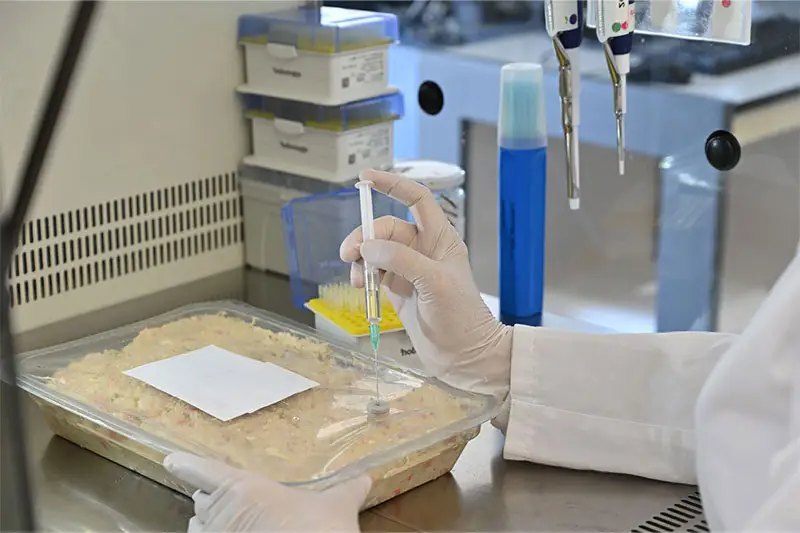Total Aerobic Microbial Count in Cosmetic Formulations Testing
The total aerobic microbial count (TAMC) is a critical parameter used to evaluate the microbiological safety of cosmetic products. This test measures the number of viable aerobic microorganisms present in a cosmetic formulation and is an essential step in ensuring product quality, safety, and compliance with regulatory standards.
Microbial contamination can lead to spoilage, increased risk of infection, and other adverse effects on consumers. By determining the TAMC, manufacturers can identify potential issues early in the development process or during production, allowing for corrective actions to be taken promptly.
The testing method involves inoculating a known volume of the cosmetic formulation into appropriate media under aerobic conditions. After incubation, colonies are counted and reported as CFUs/mL (colony-forming units per milliliter). The results provide valuable insights into the microbial load within the product, enabling companies to make informed decisions regarding quality assurance.
Compliance with relevant standards such as ISO 22716:2011 ensures that manufacturers adhere to best practices and maintain consistent product safety across different regions. This testing procedure is particularly important for personal care items like shampoos, lotions, makeup bases, and other skin-contact products where even low levels of contamination could cause significant problems.
Understanding the significance of TAMC in cosmetic formulations also helps quality managers assess their manufacturing processes more effectively. By monitoring this parameter regularly during production runs or batch releases, they can identify any deviations from expected outcomes early on, ensuring that only high-quality products reach market shelves.
Why It Matters
The significance of Total Aerobic Microbial Count (TAMC) cannot be overstated when it comes to the safety and quality assurance of cosmetic formulations. As a key indicator of microbial contamination, TAMC plays an instrumental role in safeguarding public health and ensuring consumer confidence.
Microbial growth can compromise the effectiveness and shelf life of cosmetic products while posing risks such as allergic reactions or infections if not properly managed. Regulatory bodies worldwide emphasize the importance of maintaining strict limits on microbial counts to protect consumers from these hazards. Compliance with international standards like ISO 22716:2011 helps ensure that manufacturers meet these requirements consistently.
For quality managers and compliance officers, understanding TAMC enables better decision-making throughout various stages of product development and production. Regular monitoring allows them to detect potential issues promptly, preventing costly recalls or reputational damage associated with unsafe products reaching consumers.
Industry Applications
| Industry Segment | TAMC Application |
|---|---|
| Personal Care Products | Evaluating the microbial stability of shampoos, conditioners, hair treatments, and other topical applications. |
| Makeup & Cosmetics | Ensuring the safety of foundations, lipsticks, eyeliners, and other makeup items that come into direct contact with skin. |
| Antiperspirants & Deodorants | Checking for microbial contamination in formulations designed to provide long-lasting protection against perspiration odors. |
| Sunscreens & Sunblock Creams | Determining the presence of microorganisms that might affect the efficacy and safety of these essential sun protection products. |
| Antifungal & Antiviral Treatments | Assessing the microbial content to guarantee effective treatment without introducing harmful bacteria or fungi into the formulation. |
Competitive Advantage and Market Impact
Adopting Total Aerobic Microbial Count (TAMC) testing as part of your quality assurance strategy can significantly enhance your competitive position within the cosmetics industry. By demonstrating a commitment to product safety and regulatory compliance, you not only protect yourself against legal challenges but also build trust among consumers who value transparency and accountability.
Implementing rigorous TAMC protocols shows that you prioritize consumer health above all else, which is particularly valuable given increasing awareness about the risks associated with microbial contamination. This proactive approach can help differentiate your brand from competitors who may not adhere to similar standards.
In terms of market impact, maintaining low microbial counts in your cosmetic formulations ensures consistent quality and reliability across different markets globally. Adhering to international standards like ISO 22716:2011 allows you to meet regional regulations seamlessly, opening doors for expansion into new territories where stringent safety measures are enforced.
Moreover, by investing in advanced testing methods and experienced personnel, you position yourself as a leader in the field. This leadership can attract top talent eager to work with innovative companies dedicated to excellence, further strengthening your market presence.





